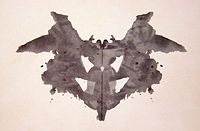
Back اختبار رورشاخ Arabic Rorşax testi Azerbaijani Тест на Роршах Bulgarian Test de Rorschach Catalan Rorschachův test Czech Rorschachtest German Τεστ Ρόρσαχ Greek Rorŝaĥ-testo Esperanto Test de Rorschach Spanish Rorschachi test Estonian
| Rorschach test | ||||
|---|---|---|---|---|
| Pronunciation | /ˈrɔːrʃɑːk/,[3] UK also /-ʃæk/ German: [ˈʁoːɐ̯ʃax] | |||
| Synonyms | Rorschach inkblot test, the Rorschach technique, inkblot test | |||
| MeSH | D012392 | |||
The Rorschach test is a projective psychological test in which subjects' perceptions of inkblots are recorded and then analyzed using psychological interpretation, complex algorithms, or both. Some psychologists use this test to examine a person's personality characteristics and emotional functioning. It has been employed to detect underlying thought disorder, especially in cases where patients are reluctant to describe their thinking processes openly.[4] The test is named after its creator, Swiss psychologist Hermann Rorschach. The Rorschach can be thought of as a psychometric examination of pareidolia, the active pattern of perceiving objects, shapes, or scenery as meaningful things to the observer's experience, the most common being faces or other pattern of forms that are not present at the time of the observation.[5] In the 1960s, the Rorschach was the most widely used projective test.[6]
Although the Exner Scoring System (developed since the 1960s) claims to have addressed and often refuted many criticisms of the original testing system with an extensive body of research,[7] some researchers continue to raise questions. The areas of dispute include the objectivity of testers, inter-rater reliability, the verifiability and general validity of the test, bias of the test's pathology scales towards greater numbers of responses, the limited number of psychological conditions which it accurately diagnoses, the inability to replicate the test's norms, its use in court-ordered evaluations, and the proliferation of the ten inkblot images, potentially invalidating the test for those who have been exposed to them.[8]
- ^ Santo Di Nuovo, Maurizio Cuffaro (2004). Il Rorschach in pratica: strumenti per la psicologia clinica e l'ambito giuridico. Milano: F. Angeli. p. 147. ISBN 978-88-464-5475-1.
- ^ Fátima Miralles Sangro (1996). Rorschach: tablas de localización y calidad formal en una muestra española de 470 sujetos. Madrid: Universidad Pontifícia Comillas. p. 71. ISBN 978-84-87840-92-0.
- ^ "Rorschach test". Dictionary.com Unabridged (Online). n.d. Retrieved 22 February 2015.
- ^ Gacano & Meloy 1994[page needed]
- ^ Dacey M (December 2017). "Anthropomorphism as Cognitive Bias". Philosophy of Science, 84(5), 1152-1164. Vol. 84, no. 5. pp. 1152–1164. doi:10.1086/694039.
- ^ Cite error: The named reference
chapmanwas invoked but never defined (see the help page). - ^ Exner JE (2002). The Rorschach: Basic Foundations and Principles of Interpretation: Volume 1. Hoboken, NJ: John Wiley & Sons. ISBN 978-0-471-38672-8.[page needed]
- ^ Scott O. Lilienfeld, James M- Wood and Howard N. Garb: What's wrong with this picture? Archived 2010-12-24 at the Wayback Machine Scientific American, May 2001
